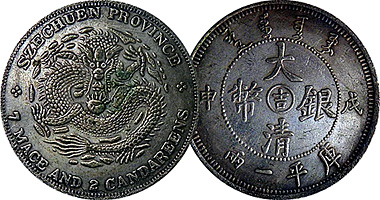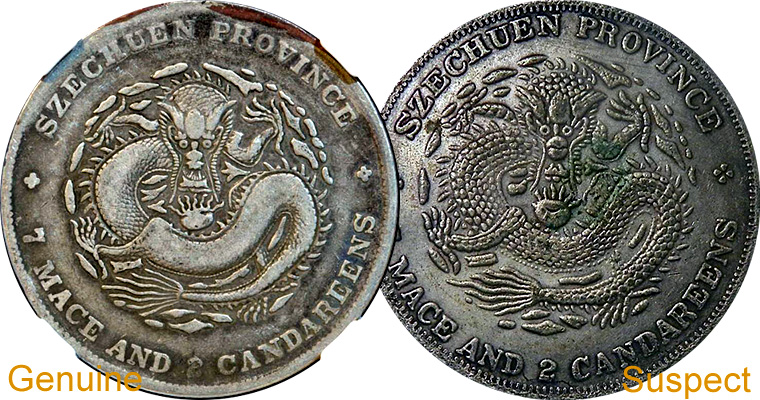

The dragon is one of the favorite patterns of Chinese coins. Conversion of the monetary units goes like this:
3.6 candareens = 5 cents
7.2 candareens = 10 cents
1 mace and 4.4 candareens = 20 cents
3 mace and 6 candareens = 50 cents
7 mace and 2 candareens = 1 dollar
Szechuan Province issued 50 cents and 1 dollar coins in silver between 1901 and 1911.
Many of today's catalogs are less generous with the values they quote for these coins. According to Anthony LLano, an expert on Chinese coins,
'This type of field is new even for the Chinese. As the early Chinese coin market gets hot, people are starting to realize how few of these coins there are. This is why the price is going up. This process will happen naturally because of the low availability of the coins.'
All in all, like many things Chinese, the field of Chinese coin collecting is new and exciting. We have taken our best shot at representative values for the Szechuan coins below, but actual prices vary widely.
50 CENTS (3 mace and 6 candareens)
worn: $45
average circulated: $225
well preserved: $600
fully uncirculated: $2000
1 DOLLAR (7 mace and 2 candareens)
worn: $35
average circulated: $85
well preserved: $210
fully uncirculated: $4000
coins with '3 candareens' instead of '2 candareens': $150 average circulated, $6000 fully uncirculated
Use our Important Terminology page to convert the catalog values above to actual values.
You must watch out for counterfeits on all valuable coins, and coins from China are particularly susceptible to fakes. There is a giant counterfeit industry in China which is setting the rare coin business on its ear.
The coin in our primary picture comes from an eBay seller we will not name. CoinQuest is not an authentication agency, but my guess is that the eBay coin is a fake. You can see the difference in minute details in the side-by-side comparison picture below. The coin on the left is certified by NGC and is therefore almost surely a genuine Szechuan dollar. (You can see part of the white NGC holder around the edges of the lefthand image.) The coin on the right is suspect.
Be careful of spending a lot of money on rare coins from a dealer you do not know well.

About CoinQuest | Privacy Policy | Contact CoinQuest
Copyright 2009 to 2024 CoinQuest.com, all rights reserved.
Daily visitors 230, minutes per visit 6.2, daily coin views 575